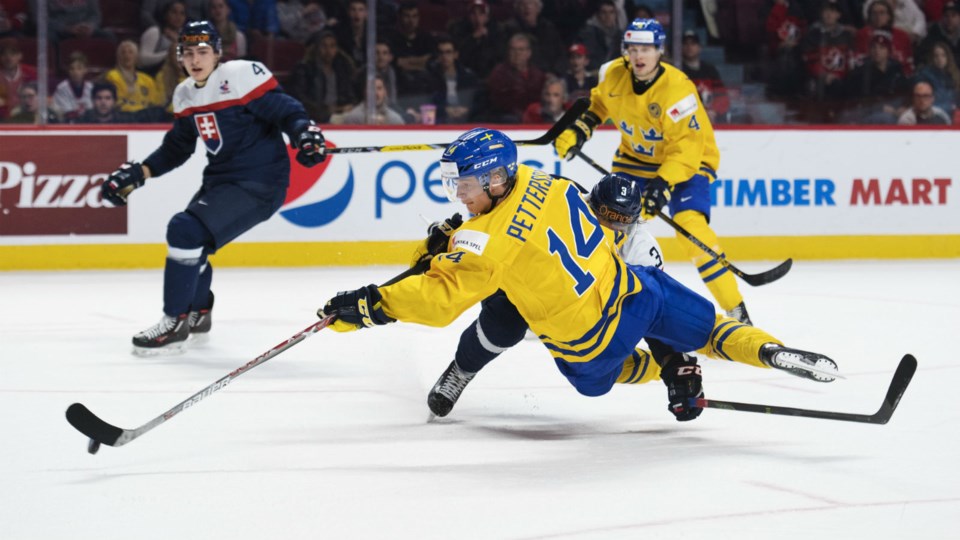Canucks fans are understandably excited about Elias Pettersson, the most skilled player the Canucks have drafted in years. He even won over some skeptics with his slick hands at the summer showcase, scoring a couple of ridiculous goals that showed he is a step above the rest of the Canucks’ prospect pool.
Part of the excitement surrounding Pettersson comes from his performance against men in the Allsvenskan, Sweden’s second-tier professional league. Pettersson had 41 points in 43 games, plus another 6 points in 2 post-season games, for a total of 47 points in 45 games. That’s unprecedented for a player in his first year of draft-eligibility in the Allsvenskan and he finished 9th in league scoring.
But then ESPN’s Corey Pronman threw a spanner in the works, pointing out that Pettersson had an abnormally high shooting percentage.
Interesting stat for VAN fans, Elias Pettersson shot 17.8% in Allsvenskan. 15th highest SH% among players with 40 GP https://t.co/sZ3ej2s9tQ
— Corey Pronman (@coreypronman) July 11, 2017
Why does this matter? Because a high shooting percentage is, in general, not repeatable. Shooting percentage is determined partly by skill, but also partly by luck. Sometimes you score a goal by undressing a defenceman and roofing a wrist shot top corner and sometimes you score when your centring pass hits a defenceman’s butt and goes in.
So, if Pettersson’s scoring in the Allsvenskan was boosted by an unsustainably high shooting percentage, that might be a concern.
The first thing to keep in mind is that higher shooting percentages can be potentially more sustainable in lower-level leagues, where a skilled scorer can take advantage of weaker goaltenders to score more goals with fewer shots.
Over the last three seasons in the Allsvenskan, for example, Patrik Karlkvist has maintained a 17.83% shooting percentage. A counter-example is Erik Nystrom, who put up 18 goals with a 19.78% shooting percentage in 2015-16, then managed just 5 goals with a 10.00% shooting percentage in 2016-17.
Looking at the last two Allsvenskan seasons, we can see if players tend to maintain a high shooting percentage. Looking at 24 skaters who had a shooting percentage higher than 14% in 2015-16 and returned to play in the Allsvenskan the following season, we can see that their shooting percentage did decline overall in 2016-17. The average shooting percentage among that group in the first season was 16.71%; in the second season it was 12.63%.
Overall, that’s not a huge decline and several players did maintain their high shooting percentage or even better it. But even if we replace Pettersson’s shooting percentage with that lower number, his season still looks outstanding.
A 12.6% shooting percentage would give Pettersson 14 goals instead of 19, and 36 total points. That’s a point-per-game rate of 0.84, still better than the next best Allsvenskan season by a player in his draft year.
That next best player is William Nylander, who put up 27 points in 35 Allsvenskan games in his draft year. His shooting percentage that season was 17.65%, just a little below Pettersson’s this past season.
Nylander went on to score 20 points in 21 SHL games in his post-draft year and just put up 61 points in the NHL this past season at the age of 21. It looks like his high shooting percentage wasn’t anything to worry about.
What’s nice is that we don’t have to just look at numbers for Pettersson: we can actually see all of his goals in the Allsvenskan last season.
Certainly, he was fortunate to score a couple of those goals, but the vast majority simply show just how skilled and intelligent he truly is. You’re going to have a high shooting percentage when you can consistently sneak in behind the defence for breakaways and have silky smooth hands to undress goaltenders.
One final thing to point out: Pettersson’s calling card isn’t even his goalscoring. He’s known primarily for his playmaking. When Jason Botchford asked Jonathan Dahlen if he was ever surprised that Pettersson was able to find him with a pass, Dahlen replied, “Not anymore.”
Dahlen got so used to Pettersson finding him with seeing-eye passes that it just became routine. He would get open and somehow Pettersson would find him with the puck. It’s more likely that Pettersson will put up points with his assists than with his goals, so his shooting percentage will be even less of a concern.



